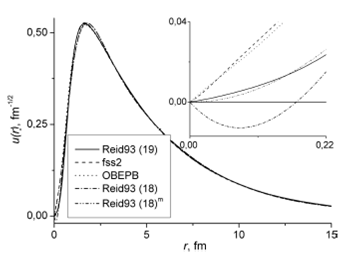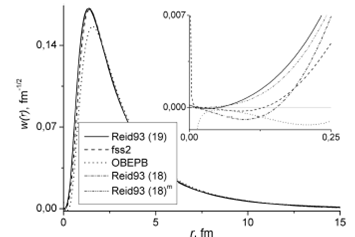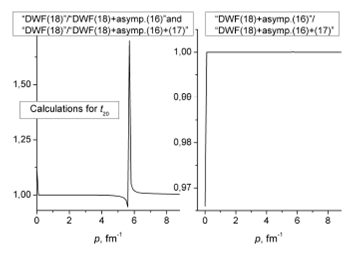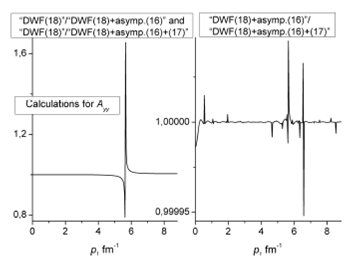1.Introduction
The deuteron is a coupled system consisting of two nucleons (neutron and proton) 1,2. The cognitions about such a few body-nucleon system allows us to study the features of the deuteron behavior of both the two-particle system and the nucleon-nucleon interaction, taking into account various forms of potential models and approaches. The calculated theoretical values of polarization observables in processes with the participation of deuteron (electron-deuteron scattering, deuteron-proton scattering, A(d,d’)X reactions on light nuclei, and others) can be compared with experimental data. Theoretical calculations of the polarization characteristics for such processes are based on the deuteron wave function (DWF) in coordinate representation.
On the one hand, the deuteron is fairly well studied both theoretically and experimentally. Static parameters have been reviewed and identified repeatedly. However, on the other hand, there are some inconsistencies and problems. One of these problems is related to the peculiarities of the behavior of the radial DWF near the origin of coordinates. Examples of this behavior are Refs. 3,4, where the DWF contains an superfluous knot for one or both components in coordinate representation. There are two reasons for this inconsistency. The first reason is related to numerical inaccuracies for the determination of DWF when using certain program algorithms (codes) 5. The second reason is related to the use of nucleon-nucleon interaction potentials.
Given these behavioral features for DWF, accurate studies for DWF can be performed near the origin of coordinates. By learning about the reliable information about asymptotics for DWFs or making the right fit for them, we can begin to calculate polarization characteristics for important processes, where the deuteron plays a key role as a target or incident beam. For this purpose it is necessary to conduct modeling for DWF in coordinate representation using one potential of nucleon-nucleon interaction.
The purpose of this study is the modeling of DWF in coordinate representation with subsequent use to find polarization characteristics. In this case, the asymptotics near the origin of coordinates and at infinity must be taken into account for DWF. For a more correct and simplified task, we will use one nucleon-nucleon potential. It will be the potential Reid93 from the Nijmegen group 6,7.
2.Deuteron wave function in coordinate representation
DWF as the main characteristic describes the deuteron as a quantum mechanical system. The knowledge of DWF allows us to obtain the maximum information about this coupled system for neutron and proton, as well as to theoretically calculate and predict those characteristics that depend on DWFs measured in the experiment.
In the theoretical description of DWF forms, such denominations 8 as “analytical form”, its “approximation” or “parameterization” are used in the coordinate representation. Often, the appellation “analytical form” is used as the resulting solution to the Schrödinger bound system. Later in the papers, this label is used to refer to records obtained as a result of the approximation for DWF.
In a detailed review 8 for the 1940-2015 years, the static parameters of deuteron, which were calculated by the DWF for various potentials and models, are systematized and described. The presence or absence of knots near the origin of coordinates for the radial DWF in coordinate representation is indicated. According to the references in the cited literature, an overview of analytical forms for DWFs was conducted. In addition, the asymptotic behavior of the DWF near the origin of coordinates and for large distances is analyzed.
The analysis of the relationships for DWFs shows 8 that most analytical forms and parameterizations are presented in the form of exponential expansions.
Consider the DWF in coordinate representation in detail. When considering specific problems in order to determine the polarization characteristics, it is necessary to select the available DWFs in the literature or to find these functions independently. In the first case, researchers pay attention to the simple recording and convenient form of such DWF. In the second case, the DWF is calculated using the coupled system for Schrödinger equations and the nucleon-nucleon potential in the coordinate space. The obtained numerical values of DWFs are logical to represent in the form of visual, simple and convenient approximations.
After selecting the approximation dependence for the description of the DWF in coordinate representation, the model DWF should be analyzed. There are three steps to this end.
The first step is to find the difference between the numerical data and the approximation form. This difference is characterized by integrals 3 for the S- and D- states of the deuteron respectively
or by the magnitude of X 2 corresponding to the degree of freedom
where n - the number of points of the array yi of the
numerical values of DWF in coordinate representation; f-
approximating function for u(r) or w(r);
The second step investigates the static parameters for the deuteron. The obtained DWF in the numerical calculations is tested for compliance with the theoretical values of deuteron static parameters and their experimental data. This is a must, since these static parameters are determined by DWF in coordinate representation 3,9,10:
- the radius (“matter radius”) of deuteron:
- the electric quadrupole moment:
- the contribution of D-state:
- the magnetic moment:
- the asymptotics of D/S- state:
where AS and AD are the asymptotics of the normalization of the S- and D- state wave functions. The value μs = μn + μp in Eq. (4) is the sum of the magnetic moments of the neutron and proton. The values of the deuteron magnetic moment are given in nuclear magnetons μN.
Only after passing these three steps, the obtained DWF can be used to calculate the polarization observables in processes involving deuteron.
3.Superfluous knots of the deuteron wave function in coordinate representation
The calculated values of the static characteristics of the deuteron are in good agreement with the experimental data. However, there are some theoretical inconsistencies and problems. Thus, in some Refs., one (for example, for OBEP 11, Bonn 3 potentials) or both (for RSC 12, Moscow 4, renormalized chiral and potentials) components for radial DWF have knots near the origin of coordinates. As noted earlier, this is also related to the features of the potential models for describing the deuteron. Next, we will look at the confirmation of this reason.
In 14 it was noted, that there is one coupled allowed state in the D- wave. This state together with the S- wave determines the ground state of the deuteron.
As noted in 15, the wave function
for the S-wave in a deuteron is of the form 2 s and a knot at
In the context of chiral effective theory (XET) 16, oscillations are available in
the numerical integration of values
There are no knots for DWF in the coordinate representation for the Nijmegen group potentials 7, as well as for Argonne v14 and v18 17, Paris 18 potentials.
4.Polarization characteristics and the deuteron wave function
Among the large set of polarization characteristics in processes with the participation of deuteron 19, we choose such quantities that characterize two different processes. This is a tensor deuteron polarization t20 for elastic electron-deuteron scattering and a tensor analyzing power Ayy for inelastic scattering of deuterons (A(d,d’)X reaction at light nuclei).
The first polarization characteristic of t20 is an important value because it is expressed through three deuteron form factors (FFs) and is determined by the experiment. At the same time, the magnitude of tensor polarization t20 is determined by the functions of structure A(p), B(p) and the scattering angle θ. Tensor deuteron polarization t20 is represented as 1,2,20-22
An alternative name for t20 is the tensor deuteron analyzing power 23,24 and is often indicated to as t20.
Here the factor S(P, θ e )=A(p)+B(p)tg 2 (θ e /2) depends on electrical and magnetic structure functions of a deuteron 1,2,25
Charge GC(p), quadrupole GQ(p), and magnetic GM(p), deuteron FFs contain information about the electromagnetic properties of a deuteron 2,26:
Here, the “body factors” D i are determined by the DWF in the coordinate representation u(r) and w(r):
Here GEN = GEp + GEn; GMN = GMp + GMn are the isoscalar electric and magnetic FFs; GEp and GEn are proton and neutron isoscalar electric FFs; GMp and GMn are proton and neutron isoscalar magnetic FFs; j0, j2 are spherical Bessel functions of zero and second order from argument pr/2. The dipole form was used for electromagnetic nucleon form factors.
Experimental data for tensor deuteron polarization t20(p) are given in the Refs. of Bates 21,27,28, JLab 22 29, VEPP-3 30-34, NIKHEF 35,36, Saclay 37, BLAST 23,24,38 collaborations and in Boden 39, Garcon 21, Abbott 40 reviews.
To estimate the tensor analyzing power Ayy as the polarization observables
in the A(d,d’)X reaction, we can use the models of plane wave impulse approximation
(PWIA) 41 and
The magnitude of the tensor analyzing power Ayy can be experimentally obtained from the numbers of deuterons n+, n-, n0, which registered for different modes of beam polarization pz, pzz, and normalized to the beam intensity, taking into account the effect of dead installation time:
Tensor analyzing power in PWIA is theoretically calculated by the following formula :
where Tij(p/2) are the amplitudes, which are determined by the radial DWF in the coordinate representation u(r) and w(r):
Here, S0 and S2 are the spherical (charge) and quadrupole FFs of the deuteron
expressed through spherical
In Eq. (10), the parameter
The experimental data for the tensor analyzing power Ayy are given for the
reaction of type (d,d’) on light nuclei: on hydrogen 46, carbon 46-48, beryllium 42-44. From the data of the tensor analyzing ability is
determined by the formula:
It is better to calculate those polarization characteristics that are sufficiently defined in the experiment. Then, we can compare theoretical calculations with experimental data over a wide range of transmitted momentums. As a consequence, the conclusion of model calculations and the satisfaction of a particular potential model for experiment will be fully justified.
5.Calculations and results
Numerical calculations show that a certain number of additions to the expansion sums for DWF in coordinate representation will show a superfluous knot near the origin of coordinates. More often this effect is present at small number of additives. To eliminate this effect, it is necessary to increase the number of additions in the sum of the expansions. However, this can lead to large rounding errors.
The second feature of the calculations for DWF in the coordinate representation is
its form of asymptotics at r → 0 and at
in Ref. 49
in Ref. 50
The standard asymptotics for DWF as
where
To approximate the DWF in coordinate representation for Reid93 potential, we use the following forms 51,52
The degrees for rn before the sums of the expansions were chosen optimal so that the obtained DWF satisfies the static parameters.
Application of the approximation to DWF for Reid93 potential by the formulas
does not cause the knot to appear only in the component u(r). Here
Figures 1 and 2, also show the DWFs for OBEPB and fss2 models for qualitative comparison. The indicated DWF behavior near the origin of coordinates indicates the numerical problems of the calculations.
Without going into the details of obtaining these asymptotics (16) and (17), we apply them to our model representations of DWFs. The submission area for DWF was actually divided into three parts:
The reason for this division into three regions below is explained by the peculiarities of the numerical calculations for (18).
In numerical calculations of DWF for potential Reid93 by formulas (18), a superfluous knot was found at r = 0.172 fm and 0.154 fm for the components u(r) and w(r), respectively (Figs. 1 and 2). This superfluous knot near the origin of coordinates is prevented by approximation. For example, you can use the approximation in the form (16) 50 to coordinate values r = 0.301 fm. The asymptotic behavior of DWFs as r→∞ is chosen as (17). In Figs. 1 and 2, this DWF modification is designated (18) m .
In Figs. 3 and 4 present the results of calculations of the polarization
characteristics of t20 and Ayy for the model calculations for
the DWF for Reid93 potential by (18). The optimal number of additions in (19) for
Reid93 potential is n = 17. The difference between these calculations is due to
different expansions and high-momentum component. The theoretical values obtained
are compared with the experimental data. In Fig.
4 uses t- scaling according to the elementary notation by the formula
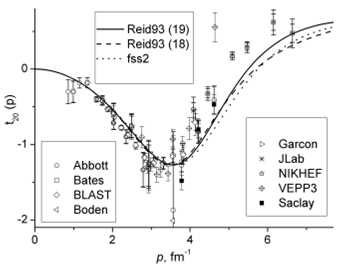
Figure 3 The tensor deuteron polarization t20, as function of transmitted momentum p. The experimental data are taken from Refs. 21-24,27-40.
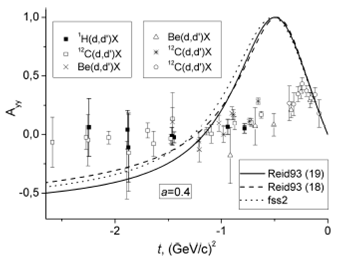
Figure 4 The tensor analyzing power A yy , as function of transmitted momentum p. The experimental data are taken from Refs. 42-44,46-48.
For the polarization characteristic Ayy, the difference between theoretical calculations and experimental data (for Ndata = 45 values) is described by X2/Ndata, which is equal to 0.159425, 0.132223 and 0.153614 for DWFs for the potentials fss2, Reid93 (18) and Reid93 (19), respectively. Similarly for the characteristic t20 (at Ndata =96), these values are given as 0.090236, 0.067306 and 0.068475. The smaller the deviation X2/Ndata, the better the theory describes the experiment in a given region of transmitted momentums. That is, the theoretical calculations with DWF for the Reid93 potential by (18) are better consistent with the experiment.
Figure 5 compares the results of t20 for the approximation (18) for potential Reid93. It takes into account the peculiarities of the DWF behavior at different coordinate regions according to (20). Purely calculations for (18) are designated as “DWF (18)”. The refinement of the asymptotics to r = 0.301 fm by the formula (16) is denoted as “DWF (18) + asymp. (16)”. If we consider asymptotics (17) after the coordinate point r = 24.997 fm in the previous case, then we have the calculations “DWF (18) + asymp. (16) + (17)”.
As the analysis of the results for t20 shows, the difference between the calculations slightly depends on the specification of the asymptotic behavior of the DWF in the coordinate representation. Refinements of DWFs were compared with each other using the ratio of polarization characteristics. Ratio of “DWF (18)” / “DWF (18) + asymp. (16) ” and “DWF (18)”/“DWF (18) + asymp. (16) + (17)” were the same. This means that it is not possible to find out the difference between the asymptotics of DWF. Therefore, it is necessary to find a direct numerical difference between the results of the refinements of the asymptotics, that is, the ratio of the results “DWF (18) + asymp. (16)” and “DWF (18) + asymp. (16) + (17)”. The influence of “manual recording” of asymptotics in the calculations of the tensor analyzing power Ayy was similarly evaluated.
As can be seen from Figs. 5 and 6 there is only a slight difference in the calculations in the narrow region of the transmitted momentums. What is the reason for the difference between calculations in a small region? Obviously, we need to turn to the algorithm of numerical calculation. The peculiarity of determining the polarization characteristics is that they contain mathematical expressions with spherical Bessel functions of zero and second order. These functions are in integrals ranging from zero to infinity (formulas for elementary “body form factors” and form factors (14)).
In general, such meticulous refinements do not affect the overall appearance of the polarization characteristics. The insignificant difference between the calculations with the choice of different asymptotics does not affect the general behavior in the scale of the transmitted momentums. However, the analysis of numerical data is fully justified. And such numerical refinements based on asymptotics for DWF may be useful for further refinements for a specific accurate momentum value or for a narrow momentum interval.
The static parameters of the deuteron are shown in Table I. The data obtained are compared with the results of theoretical calculations in other studies and experimental values. The difference between them is not significant.
Table I Theoretical and experimental values of deuteron parameters: D- state contribution P D , matter radius r m , electric quadrupole moment Q d , magnetic moment µ d , the asymptotics of D/S- state η.
| Potential | PD [%] | rm [fm] | Qd [fm2] | µd [µN ] | η |
| Reid 93, DWF (18); N =17 | 5.6948 | 1.9694 | 0.26703 | 0.847356 | 0.02477 |
| Reid 93, DWF (18)+ asymp. (16); N =17 | 5.6949 | 1.9694 | 0.26703 | 0.847356 | 0.02477 |
| Reid 93, DWF (18)+ asymp. (16) + (17); N =17 | 5.6949 | 1.9689 | 0.26703 | 0.847356 | 0.02477 |
| Reid 93 (19); n=17 | 5.6992 | 1.9677 | 0.27019 | 0.847332 | 0.02458 |
| Reid 93 (19) 53 | 5.7009 | 1.9671 | 0.27015 | 0.847322 | 0.02426 |
| Reid 93 6, 56 | 5.699 | 1.969 | 0.2703 | - | 0.0251 |
| Nijm I 6, 56 | 5.664 | 1.967 | 0.2719 | - | 0.0253 |
| Nijm II 6, 56 | 5.635 | 1.968 | 0.2707 | - | 0.0252 |
| Nijm 93 6, 56 | 5.755 | 1.966 | 0.2706 | - | 0.0252 |
| Argonne v18 17 | 5.76 | 1.967 | 0.270 | 0.847 | 0.0250 |
| Experiment 1 | - | 1.975() | ) | 0.857438 | 0.0256() |
6.Conclusions
The simulation for DWF in coordinate representation for the nucleon-nucleon potential Reid93 is performed. For this purpose, we take into account the asymptotics of the radial DWF near the origin of coordinates and at infinity. Such asymptotics, which are the most simple and physical, are applied.
Compensated superfluous knots for both DWF components in coordinate representation to the coordinate value r = 0.301 fm are illustrated.
On the basis of the obtained DWFs in the coordinate representation, two polarization characteristics of t20 and Ayy were calculated. Taking into account the asymptotics of the wave function has little effect on the general behavior of these polarization characteristics. Particular points of the transmitted momentum have been identified, where the tensor deuteron polarization t20 and the tensor analyzing power Ayy show a clear difference.











 nueva página del texto (beta)
nueva página del texto (beta)

